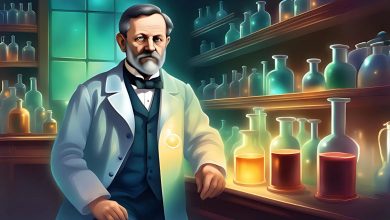
In 1927, Thomas Parnell, the first Professor of Physics at the University of Queensland, signed the ” Pitch Drop Experiment “, one of the longest-running experiments in history. In fact, the Professor’s only purpose was to tell his students that not every solid-looking substance like the pitch is actually solid, furthermore, they could be fluid under room conditions, but we are sure that he himself would not have predicted that this experiment would take more than 92 years.
What is Pitch?
Bitumen is a black and dense substance that is impermeable to water, obtained as a result of the distillation of petroleum. In fact, although it is fluid in room conditions, its appearance is indistinguishable from stone. From here, we can understand how high the resistance (viscosity) of the pitch against the flow is.
One of the usage areas of bitumen is asphalt production. So yes, if you have walked on an asphalt road even once, you can claim that you are walking on a fluid substance!
Back to Our Experience
Professor Parnell first poured a piece of bitumen, which he brought to high temperatures, into an inverted funnel-shaped glass vessel. After waiting for 3 years for it to completely cool and harden, he cut off the closed pointed end of the funnel, and thus our experiment, which continued for more than 92 years, began.

The First Drop Dropped After 8 Years!
With the first drop falling in December 1938, the professor proved his claim. However, no one witnessed the drop of pitch dripping, which was eagerly awaited by many for years. Although the experiment completed its purpose, the experiment was not stopped in order to see the dripping moment of the pitch. The second drop that fell in 1947 shared the same fate as the first drop. Unfortunately, Professor Parnell, who could not witness the fall of any drop, died in 1948. John Mainstone, head of the Mathematics and Physics department at the same university, took over the experiment. Professor Mainstone, who devoted the remaining 52 years of his life to the experiment, could not witness even one of the 5 drops dripping in this process. In fact, no one testified.
| 1927-1930 | Preparation Phase |
| December 1938 | 1st Drop |
| February 1945 | 2nd Drop |
| April 1954 | 3rd Drop |
| May 1962 | 4th Drop |
| 1970 August | 5th Drop |
| 1979 April | 6th Drop |
| July 1988 | 7th Drop |
| November 2000 | 8th Drop |
| April 2014 | 9th Drop |
Because the experiment was not stored in stable ambient conditions, environmental factors such as climate changes made it very difficult to predict when the drops would fall, some in 8 years, and some in 14 years. The size of the pitch drop and the thinning of his neck as a string were a big clue, of course. It was just at such a time that Professor Mainstone followed the experiment closely, hoping to see the fall of the 6th drop. He didn’t go home on a Friday night and woke up next to the setup, but nothing happened. Our professor, who was not willing to go home yet, kept his watch on Saturday and returned home on Sunday, exhausted and empty-handed. Yes, as you can imagine… when he got back to work on Monday, the drop had already fallen….

How ironic that 9 years later, our professor, who followed the 7th Drop closely, missed the moment of falling because he went to buy coffee this time.
8th and 9th Drops Recorded on Camera
Now there was something on which everyone agreed; A human couldn’t watch the experiment for days alone, but a camera could. In the 2000s, with the spread of technology, a camera system was installed around the experimental setup. When the 8th Drop fell in November 2000, the camera recordings were viewed with great excitement. You know what Murphy’s laws say; If something can go wrong, it will. Frustration! The camera could not record due to a malfunction! Despite the 70 years that have flown by, 8 drops fell and we were still empty-handed.
But don’t give up, for the 9th drop, besides the camera system, live broadcasting now started all over the internet. Unfortunately, Professor Mainstone passed away in 2013. Just a few months later, in 2014, the 9th Drop fell. In fact, it would not be correct to say that it is falling. Something unforeseen happened. Since there was not enough space in our glass beaker, which was filled with drops falling in the past, the 9th drop touches the other drops before they can fall and hangs without breaking. If you wish, you can watch this moment in the video below:
For the first time since the beginning of the experiment, the apparatus is opened and the beaker is moved and the neck of the pitch drop is broken. This adventure, which is full of misfortunes that feel like a joke, dates back to 1930.
The pitch drop experimental setup is currently on display at the University of Queensland museum and is also broadcast live on the Internet. (http://thetenthwatch.com/feed/) Who knows, you may be one of the lucky ones who saw the 10th drop!
Before we end this delightful article, let’s leave a guess for the 10th drop: We believe that a sweet April morning in 2029 will see this drop meet the ground. Of course, we could be making it up. We’ll wait and see! Or we won’t 🙂
References and Further Reading
Explainer: The Pitch Drop Experiment. UQ News. (2014, November 10). Retrieved August 11, 2022, from https://www.uq.edu.au/news/article/2014/11/explainer-pitch-drop-experiment
Guardian News and Media. (2022, April 29). ‘it’s literally slower than watching Australia Drift North’: The laboratory experiment that will outlive us all. The Guardian. Retrieved August 11, 2022, from https://www.theguardian.com/education/2022/apr/30/its-literally-slower-than-watching-australia-drift-north-the-laboratory-experiment-that-will-outlive-us-all
Pitch drop experiment. School of Mathematics and Physics – University of Queensland. (2021, February 15). Retrieved August 11, 2022, from https://smp.uq.edu.au/pitch-drop-experiment
The proofreading has been done by Asu Pelin Akköse and Mete Esencan.
Would you like to support us?
- For more detailed information, you can check our “Support Us!” page!






